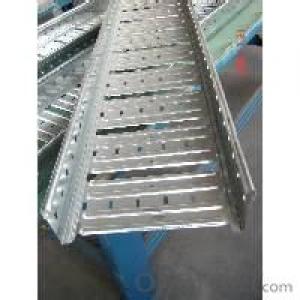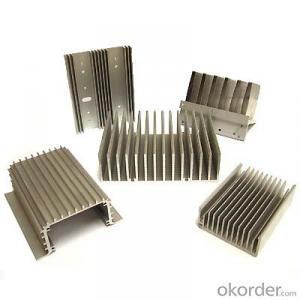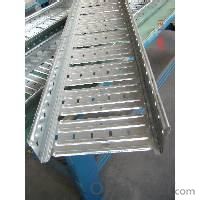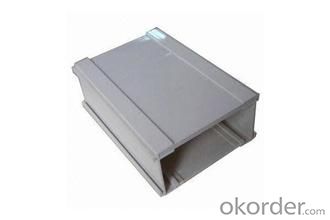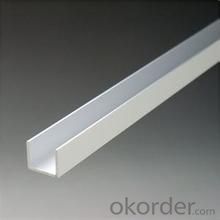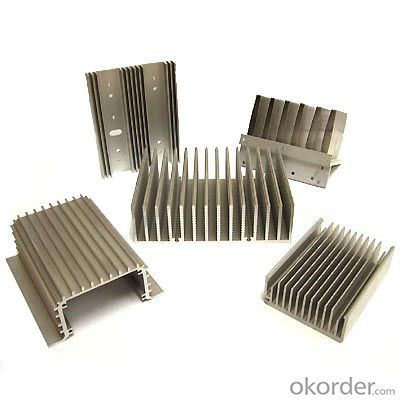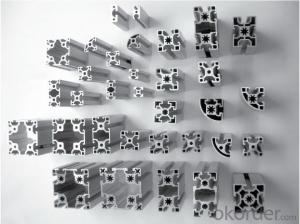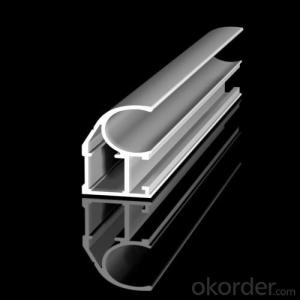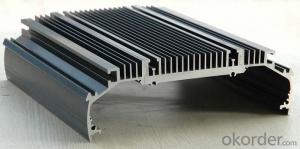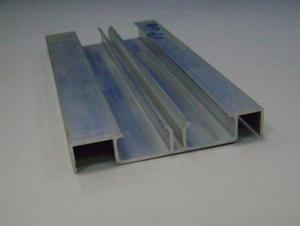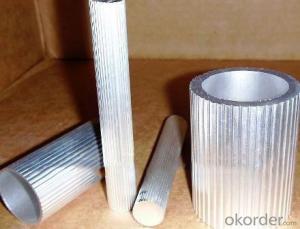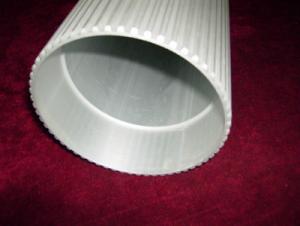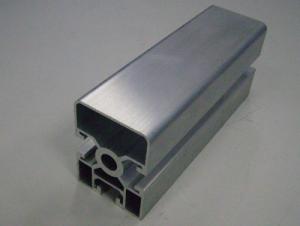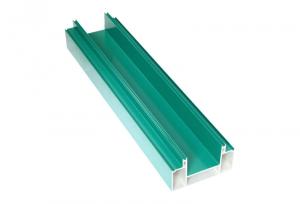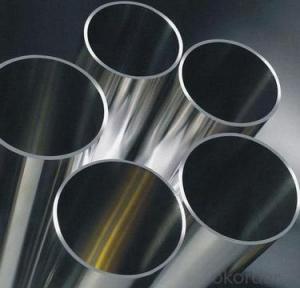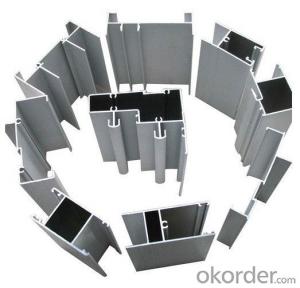Extrusion Aluminum Profiles - Aluminum Frame Aluminum Profile
- Loading Port:
- China Main Port
- Payment Terms:
- TT OR LC
- Min Order Qty:
- -
- Supply Capability:
- -
OKorder Service Pledge
OKorder Financial Service
You Might Also Like
Aluminium profile
1) Alloy: AA6061, AA6063
2) Temper: T5, T6
3) Series of surface treament:
1. Mill Finished
2. Anodizing: Silver, champagne, light bronze, dark bronze, black, light titanium, dark titanium.
3. Electrophoretic Coating: Silver, champagne, bronze, black, light bronze, dark bronze.
4. Electrostatic Color Powder Coating: Normal color, special color.
5. Fluorocarbon Powder Spraying: Normal color, special color.
6. Wood Grain Coating: Import paper, domestic paper.
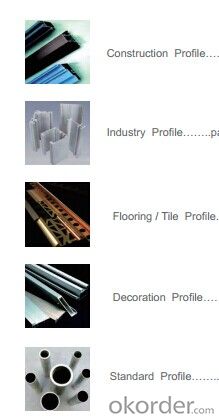
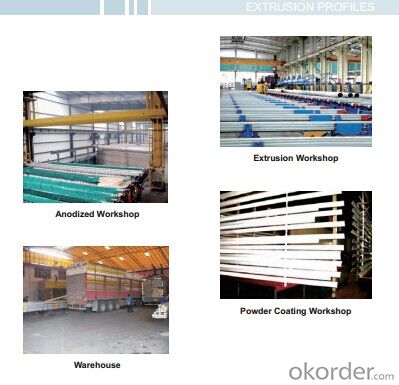
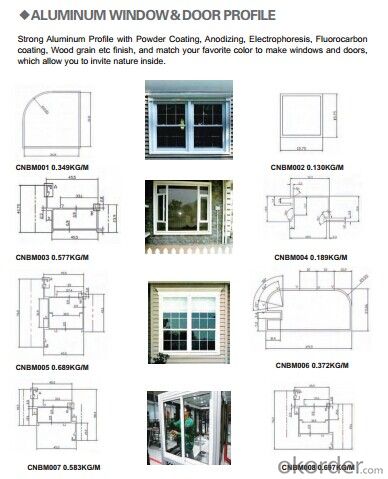
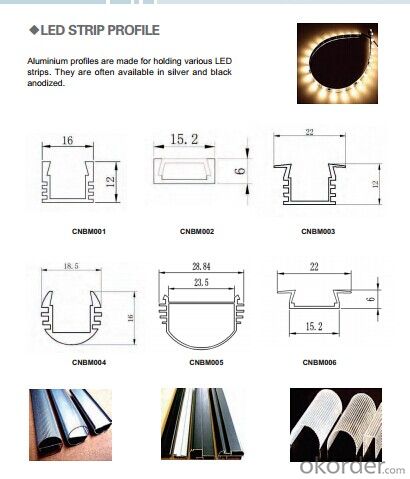
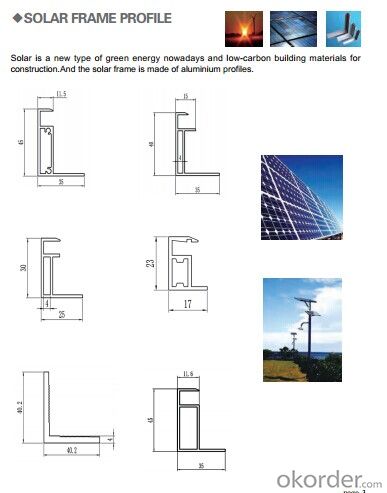
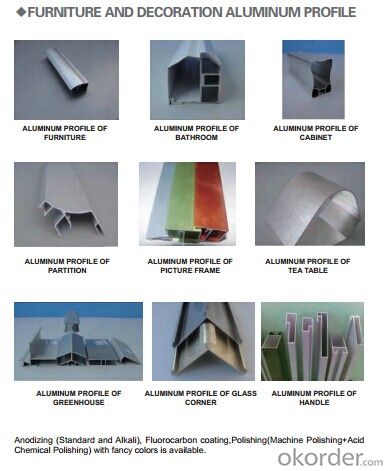
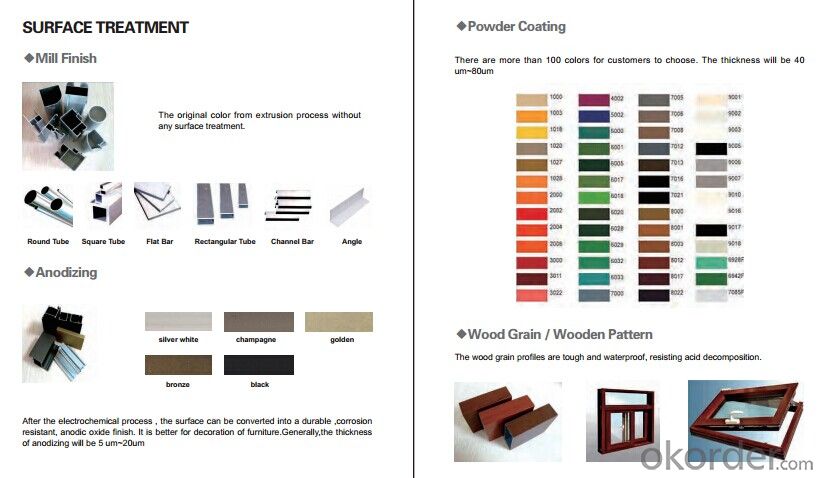
- Q: Can aluminum profiles be used for solar panel installations?
- Yes, aluminum profiles can be used for solar panel installations. Aluminum is a lightweight and durable material that is commonly used in the construction of solar panel frames. It provides excellent support and stability for the panels, while also being resistant to corrosion and weathering. Additionally, aluminum profiles can easily be customized and fabricated to meet specific installation requirements, making them a suitable choice for solar panel installations.
- Q: How do you ensure proper weatherproofing with aluminum profiles?
- To ensure proper weatherproofing with aluminum profiles, there are several key measures that can be taken. Firstly, it is important to select high-quality aluminum profiles that are specifically designed for weather resistance. These profiles should be treated with a suitable finish or coating that provides protection against corrosion and weather elements. Next, proper installation techniques should be followed to ensure a tight and secure fit. This includes ensuring that the profiles are correctly aligned and joined together using appropriate fasteners or adhesives. Any gaps or openings between the profiles should be sealed with weatherproofing materials such as silicone or rubber gaskets to prevent water or air infiltration. In addition, it is crucial to pay attention to the design and construction of the aluminum profiles. This involves incorporating features like sloped surfaces, drip edges, and drainage systems to facilitate water runoff and prevent pooling or accumulation. Adequate provisions should also be made to address thermal expansion and contraction, which can affect the weatherproofing performance of the profiles. Regular maintenance is another important aspect in ensuring long-lasting weatherproofing. Periodic inspections should be conducted to identify any signs of wear, damage, or deterioration in the profiles or their weatherproofing elements. Any issues should be promptly addressed through repairs or replacement to maintain the integrity of the weatherproofing system. Overall, by selecting quality aluminum profiles, following proper installation techniques, incorporating suitable design features, and conducting regular maintenance, one can ensure proper weatherproofing with aluminum profiles and enhance their durability and performance against weather elements.
- Q: What are the different surface etching options for aluminum profiles?
- Aluminum profiles offer a range of surface etching options, allowing for different aesthetic and functional outcomes. 1. One option is chemical etching, a widely used technique that involves selectively removing the top layer of material by applying a chemical solution to the aluminum surface. This method enables the creation of intricate patterns, logos, or text on the profile. 2. Another method is electrochemical etching, also known as electrolytic etching. It utilizes an electric current to etch the aluminum surface, resulting in precise and permanent markings. This makes it ideal for labeling and identification purposes. 3. Anodizing, an electrochemical process, forms a protective oxide layer on the aluminum surface. By incorporating etching, a matte or textured finish can be achieved. Anodizing with etching not only enhances corrosion resistance but also provides a decorative appearance. 4. Laser etching, utilizing high-powered lasers, selectively removes material from the aluminum surface. This technique ensures precise and detailed markings or patterns without physical contact. It is commonly used for branding, serial numbers, and decorative designs. 5. Mechanical etching involves physically scratching or engraving the aluminum surface using tools like rotary cutters or diamond-tipped styluses. This method allows for deeper and more pronounced etchings, resulting in a tactile and visually appealing texture. When selecting a surface etching option for aluminum profiles, it is crucial to consider specific requirements, end-use, and desired outcomes. Each technique offers distinct advantages and limitations. Therefore, it is advisable to consult with a professional or experienced etching service provider to determine the most suitable option.
- Q: The user is inquiring about the efficiency of aluminum profile recycling in their region and seeks details on how it can be done.
- <p>Yes, aluminum profiles can be recycled efficiently in most regions due to their high value and the relatively low energy required for recycling. The process typically involves collection, sorting, melting, and recasting into new aluminum products. To recycle aluminum profiles in your region, you can check for local recycling centers or scrapyards that accept aluminum. Some municipalities also have curbside recycling programs that include aluminum. Ensure that the profiles are clean and free of non-aluminum components before recycling to maximize their value and efficiency in the recycling process.</p>
- Q: What are the different surface patterns or textures available for aluminum profiles?
- Aluminum profiles come in various surface patterns and textures, each offering unique qualities both aesthetically and functionally. Some of the most commonly used options are as follows: 1. Sleek and Polished: The smooth surface finish is the most basic and widely used. It is achieved by grinding and polishing the aluminum surface, resulting in a sleek and polished appearance. 2. Linear Texture: Brushed aluminum profiles have a linear texture that is created by brushing the surface with an abrasive material. This gives the metal a distinctive grain and a slightly matte look. 3. Corrosion-Resistant: Anodized profiles undergo an electrochemical process that enhances the natural oxide layer on the aluminum surface. This produces a durable and corrosion-resistant finish with a wide range of color options. 4. Decorative and Durable: Powder-coated profiles involve applying a dry powder to the aluminum surface, followed by heat curing. This creates a hard and decorative finish that can be customized with various colors and textures. 5. Enhanced Grip and Friction: Textured profiles feature patterned surfaces that add visual interest and offer improved grip or friction. The patterns can range from subtle to more pronounced, depending on the desired effect. 6. Wood-Like Appearance: Wood grain finishes are achieved through sublimation, where a high-resolution image of wood grain is transferred onto the aluminum surface. This allows for the appearance of wood without the need for maintenance. 7. Raised or Recessed Patterns: Embossed profiles have raised or recessed patterns created through mechanical or hydraulic processes. These patterns can serve both decorative and functional purposes, providing enhanced grip or structural strength. 8. Slip-Resistant: Diamond plate is a type of textured finish that features a raised diamond pattern on the surface. It is commonly used in industrial or high-traffic applications for its slip-resistant properties. The choice of surface pattern or texture for aluminum profiles depends on the specific application, desired aesthetic, and functional requirements. Manufacturers usually offer a range of options to cater to different needs and preferences.
- Q: Are aluminum profiles capable of being tailored to fit the unique specifications of a construction project?
- <p>Yes, aluminum profiles can be customized to meet specific requirements of a building project. They offer versatility and flexibility, allowing for adjustments in size, shape, and design. Manufacturers can produce aluminum profiles with varying thicknesses, lengths, and finishes to suit the project's structural and aesthetic needs. Customization may include specific bends, cuts, or holes to ensure compatibility with other building components. This adaptability makes aluminum profiles a popular choice for various construction applications, from window frames to structural supports.</p>
- Q: Are aluminum profiles suitable for use in the renewable energy industry?
- Yes, aluminum profiles are suitable for use in the renewable energy industry. Aluminum is lightweight, durable, and corrosion-resistant, making it ideal for applications such as solar panel frames, wind turbine components, and electrical infrastructure. It also offers excellent thermal conductivity and recyclability, aligning with the sustainability goals of the renewable energy sector.
- Q: Are aluminum profiles suitable for use in the marine industry?
- Yes, aluminum profiles are suitable for use in the marine industry. Aluminum is a lightweight, durable, and corrosion-resistant material, making it ideal for various marine applications, including boat building, shipbuilding, and offshore structures. Its high strength-to-weight ratio allows for efficient and reliable construction, while its resistance to saltwater and harsh environmental conditions ensures longevity. Additionally, aluminum profiles can be easily fabricated, providing flexibility in design and customization. Overall, aluminum profiles offer numerous advantages that make them well-suited for use in the marine industry.
- Q: This question asks for methods to protect aluminum profiles from corrosion and damage during the processes of transportation and storage.
- <p>To prevent corrosion and damage to aluminum profiles during transportation and storage, follow these guidelines: 1. Keep aluminum profiles dry and clean. Moisture and dirt can accelerate corrosion. 2. Use protective packaging, such as plastic wrap or padded covers, to shield profiles from physical damage and moisture. 3. Store profiles in a cool, dry place away from direct sunlight and corrosive substances. 4. Stack profiles with appropriate padding between layers to prevent scratching. 5. Avoid overloading during transportation and ensure secure fastening to prevent movement and potential damage. 6. Regularly inspect stored profiles for signs of corrosion or damage and address any issues promptly.</p>
- Q: This question asks for methods to prevent rusting on aluminum profiles during the installation process.
- <p>To prevent rusting on aluminum profiles during installation, follow these steps: Ensure the aluminum profiles are clean and free from any contaminants before installation. Use stainless steel screws and fittings to avoid galvanic corrosion. Keep the profiles dry and avoid contact with moisture. Apply a protective coating or sealant if the profiles will be exposed to harsh environments. Store aluminum profiles in a dry place to prevent moisture absorption. Regularly inspect and maintain the profiles to catch any signs of corrosion early.</p>
Send your message to us
Extrusion Aluminum Profiles - Aluminum Frame Aluminum Profile
- Loading Port:
- China Main Port
- Payment Terms:
- TT OR LC
- Min Order Qty:
- -
- Supply Capability:
- -
OKorder Service Pledge
OKorder Financial Service
Similar products
Hot products
Hot Searches
Related keywords
